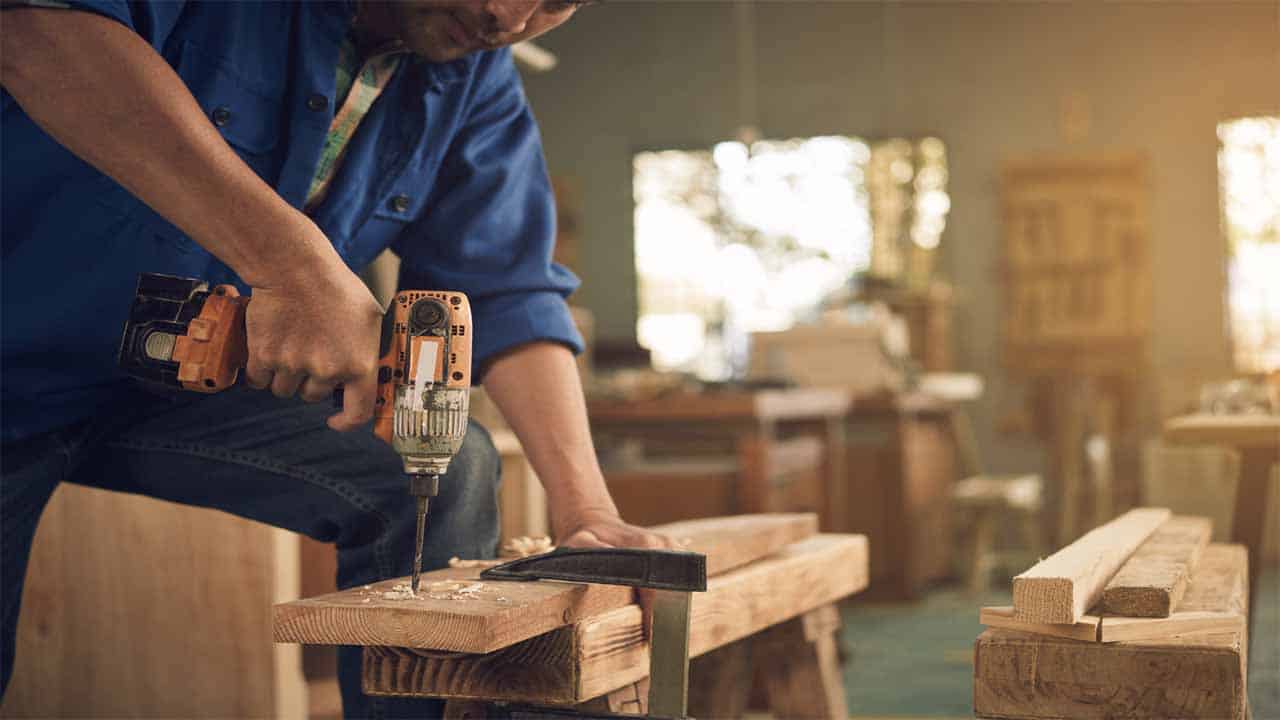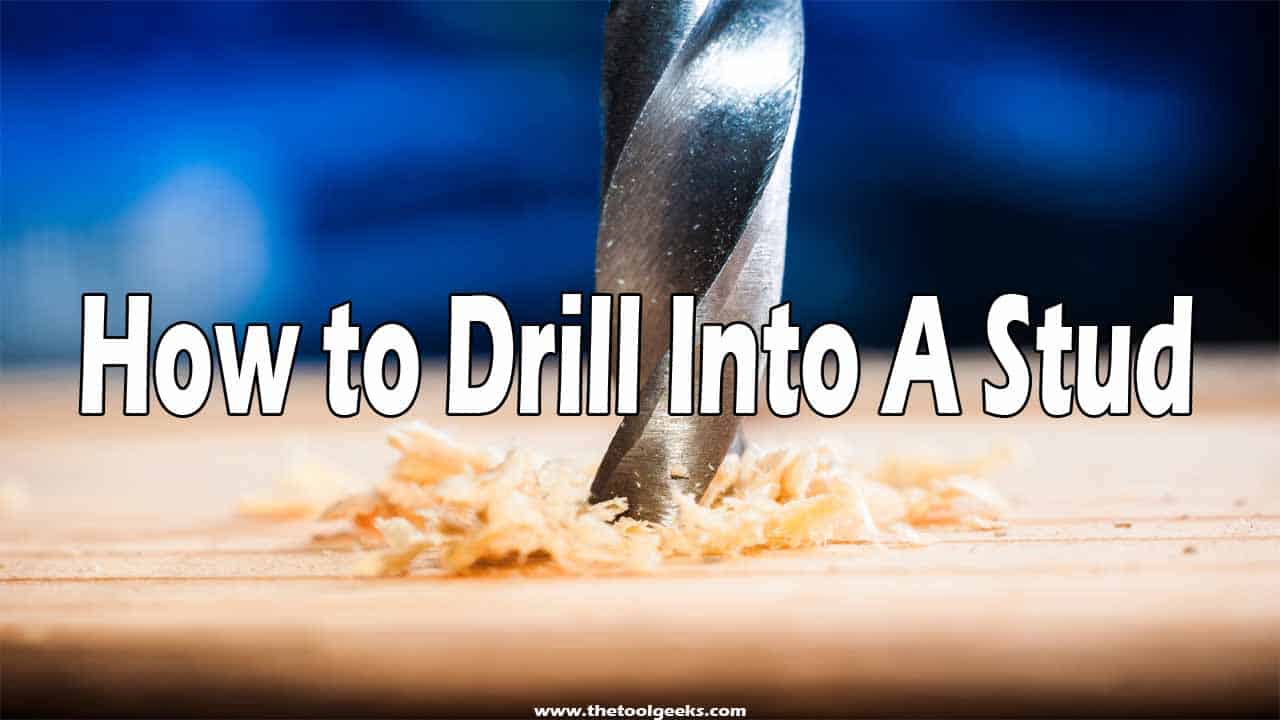How to Drill Into A Stud (5 Steps)
TheToolGeeks.com is a participant in the Amazon Services LLC Associates Program and other affiliate advertising programs. We may earn from qualifying purchases. (Learn More).
Drilling through the solid hard part of the wall to ensure the items are fixed; can be strenuous. For a first-timer, it may seem impossible since you have to drill a hole through the firm part of the wall.
The rigid sections on the walls; studs are made in different materials; they may be metallic or wooden depending on their functionality and location. The materials they are made of can be pretty unbearable to drill through the different materials.
Both metallic and wooden studs are challenging to work on. They tend to pose the same complexity when it comes to making holes or putting screws through them.
However, having in mind the kind of stud you are working on is an essential aspect of the drilling process. It eases the work for you. Since there is quality equipment to work with. Different sets of equipment are required when drilling the studs because they are made from contrasting materials.
Fortunately, it is something you can probably fix on your own. Here are some simple steps to guide you through. They will help you put up that item that’s been lying on the floor that needs to be on the wall.
Jump To Page Contents:
How to Drill Into A Stud
Gathering Your Equipment
To make holes through a metallic stud, proper drilling is required. You will need a general-purpose bit that is tough and is made from cobalt or titanium. They have a protruding section that spreads out at an angle of 118 degrees.
The drill accessories come in different shapes and sizes. They are also designed to perform in different ways. The most commonly used bits are the twist drill bits. They are specifically designed to make standard holes into a material. It can provide boreholes in both metallic and wooden studs.
Forstner bits are another kind of bit that drill large holes in wood. Spade bits; work very fast, and they bore large holes too. The holes a saw bit can make are large and can be used on both metal and wood.
In wooden studs, a wood twist drill bit is preferred; it has a mid-point which aids in placing the drill in the middle, and the drill bit is maintained in a straight position. Furthermore, tapered drill bit help avoid splitting the wood used to make the stud.
Apart from the drill and the bits, there are other equipment and material that will be required to complete the task.
Generally, you will need
- The stud wall
- Drill to fix a bit into
- Batteries for drills that don’t use power
- pencil
- Lubricating oil
- Bit preferably twist drill bit
- screws
- Tape measure to measure the center of the stud
- Power supply for the drill
- Dust mask and goggles to protect from dust and pebbles released during drilling
Safety and Precaution
Working with some of these tools may be dangerous. Make sure you are working in an environment that is safe all the time. Protect your eyes from wood dust and metal particles by wearing goggles and a dust mask. This assures you of working for more years and simplifies your work, and avoid accidents that can be prevented.

Ensure you know what’s behind the walls; the danger might be drilling through a wall and touching a power cable with the drill; this can lead to electric shock. The other might be drilling through a water pipe leading to flooding. A gas pipe could also be along the drilling path.
Understand how the drill bit works by reading through the manual of the equipment. Understanding them and using them in the right way prolongs the lifespan of the equipment.
Remember always to be safe and take precautions while taking the task, and it’s better than being sorry.
Related Read — How To Make a Hole in Stucco?
Preparing Your Drill
Using a metal drill fitted with a twisted drill bit is versatile because it can drill both wood and metal studs. When the bit is connected to a power source, ensure it is regulated at low speed.
Choose the right size of bit to use, which depends on the hole you want to drill. The bit should make it effortlessly into the tip of the drill.
Sharpening the bit is vital; dull bits will require you to put in more effort when drilling. In the end, this might cause the bits to break or result in personal injuries.
Grease the areas the bit will attach to the drill to reduce the rubbing effect on the equipment.
Connect the drill to a power source and test run it. Check for any abnormality. For drills powered by batteries, ensure they are charged for effective drilling. Check the speed setting of the, and it is drilling in the right direction.
Locating the Stud and Marking the Area
There are several ways to find a stud behind a wall. However, the easiest ones are using stud finders and finding studs manually by hitting the wall.
Figuring how to find studs using the stud finders is the easiest; they are small electronic devices run along walls to locate a stud quickly.
You will need to note down the height at which to start looking for the stud, hold the stud finder against the wall and move it along the surface, towards the left and right. The equipment produces a beeping noise or flashes a light when it senses a stud along the wall.
The other reliable and straightforward method is tapping the wall; it is a sure way to figure out that you are not drilling into drywall. Knock along the wall with your knuckles when the room is quiet; drywall will produce an empty sound a stud will echo out a solid sound.
Running a powerful rare earth magnet along the wall will get stuck where there is a metal stud; this is also a good way of finding metal studs.
After successfully locating the stud, use a pencil to note down the stud sides, its beginning and end. The wall studs are usually located 16 to 24 inches apart are about 2-inch wide.
Start the Drill
Having located and marked the stud location, the next step is the actual drilling process.
Connect the drill to a power source and turn it on. Holding the drill firmly with one hand, point the tip of the bit to the marked position. Drill a trial hole; this is to point out that it is the stud that is being drilled; and not the drywall. With the screw in the trial hole, direct the drill on it and ensure it goes in straight.
Put in some effort while ensuring the screw goes in straight into the trial hole. When the screw is firmly fixed on the wall, take your hand back and insert force to the bottom side of the drill. Depending on the material, wood will need little energy compared to metal stud.
After drilling for a while, be sure to regulate the heat produced by the drill by wiping it with cold water. This is important when drilling through rigid materials.
The screw shouldn’t go all into the wall, and this will prevent you from hanging what you were to put up on the wall.
Related Read — How To Make a Hole in Granite?
FAQs About Drilling Into a Stud
Can I Drill a Screw Straight into a Stud?
Yes, but it is not advisable; drilling a test hole using a short bit to act as a guide. It will ensure that you are not hitting any power cables, gas pipes, or even plumbing pipes. Another advantage of the pilot hole is that it is repairable if the stud was mismarked.
Are You Supposed to Drill into a Stud?
This will significantly be decided by what you are putting up in terms of its weight and size. For bulky items, the more the screw will go into the stud. At least the screw should stick out to give an allowance or attaching the frame for framed pictures.
Nevertheless, when putting in a screw into structures, you will have to screw into the stud to stand out firmly and pleasant, and the wall structure is kept in position.
What Drill Bit do I need to use for Metal Studs?
Using cobalt, oxide, titanium, or carbide-tipped twist bits offers the best results. However, any drill bit can go through studs. Destroying the bit is also a possibility of using the wrong bit.
Related Read — Screw Gun vs Drill?
What Should You do to Locate a Stud?
The simplest and easiest way to do it is to make a fist and knock on the wall with your knuckles. You will hear a hollow sound in some areas and other regions a “solid” sound. The “solid” sound indicates you knocked on a stud.
Unfortunately, this method is not 100% reliable. Using the electrical stud finders gives accurate findings.
Amazon and the Amazon logo are trademarks of Amazon.com, Inc, or its affiliates.

